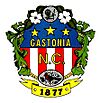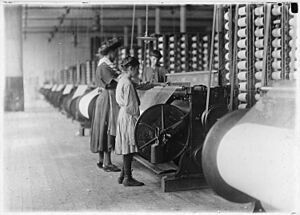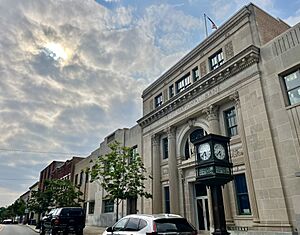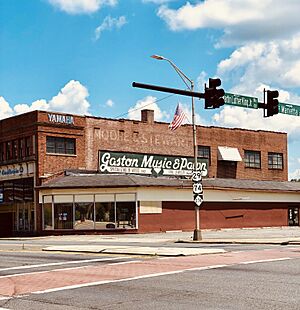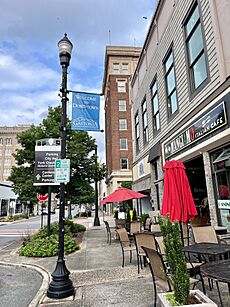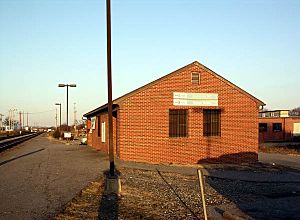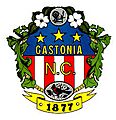Gastonia, North Carolina facts for kids
Quick facts for kids
Gastonia
|
|||||
|---|---|---|---|---|---|
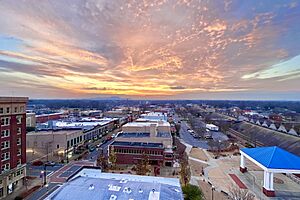
Downtown Gastonia
|
|||||
|
|||||
| Nickname(s):
Spindle City
|
|||||
| Motto(s):
"Great Place. Great People. Great Promise."
|
|||||
| Country | United States | ||||
| State | North Carolina | ||||
| County | Gaston | ||||
| Incorporated | 1877 | ||||
| Named for | William Gaston | ||||
| Government | |||||
| • Type | Council–manager | ||||
| Area | |||||
| • Total | 52.22 sq mi (135.24 km2) | ||||
| • Land | 51.99 sq mi (134.65 km2) | ||||
| • Water | 0.23 sq mi (0.59 km2) 0.44% | ||||
| Elevation | 738 ft (225 m) | ||||
| Population
(2020)
|
|||||
| • Total | 80,411 | ||||
| • Estimate
(2023)
|
83,942 | ||||
| • Density | 1,546.66/sq mi (597.17/km2) | ||||
| • Urban | 176,897 (US: 208th) | ||||
| • Urban density | 1,420.0/sq mi (548.2/km2) | ||||
| Time zone | UTC−5 (EST) | ||||
| • Summer (DST) | UTC−4 (EDT) | ||||
| ZIP codes |
28052-28056
|
||||
| Area code(s) | 704, 980 | ||||
| FIPS code | 37-25580 | ||||
| GNIS feature ID | 2403684 | ||||
Gastonia is a city in Gaston County, North Carolina, United States. It is the biggest city in Gaston County and its county seat, which means it's where the county government is located. Gastonia is also the second-largest city near Charlotte.
In 2020, about 80,411 people lived in Gastonia. This makes it the 13th most populated city in North Carolina. Gastonia is part of the larger Charlotte metropolitan area.
For a long time, Gastonia was known for making textiles (like cloth and yarn). A big event called the Loray Mill Strike happened here in 1929, which was important for workers' rights. Today, manufacturing is still a key part of the economy. But Gastonia also has strong healthcare, education, and government jobs.
Contents
History of Gastonia
Gastonia is named after William Gaston. He was a judge and a representative for North Carolina in the United States government.
The Loray Mill strike took place in Gastonia in 1929. Workers at the Loray Mill went on strike to ask for better working conditions and higher pay. This strike was a big event in the history of the labor movement in the United States. Even though the strike didn't fully reach its goals, it became famous around the world and was even featured in books written in the 1930s.
Historic Places in Gastonia
Many buildings and places in Gastonia are listed on the National Register of Historic Places. This means they are important for their history or architecture. Some of these include the City Hospital-Gaston Memorial Hospital, the Downtown Gastonia Historic District, and the Loray Mill Historic District. Other notable places are the First National Bank Building, Gaston County Courthouse, and Gastonia High School.
Gastonia's Geography
Gastonia covers about 52.22 square miles. Most of this area is land, with a small part being water. The city makes up about 14% of all of Gaston County.
Gastonia is located about 21 miles west of Charlotte. It is also about 22 miles east of Shelby. To the south, it is about 37 miles from Hickory.
Population of Gastonia
| Historical population | |||
|---|---|---|---|
| Census | Pop. | %± | |
| 1880 | 236 | — | |
| 1890 | 1,033 | 337.7% | |
| 1900 | 4,610 | 346.3% | |
| 1910 | 5,759 | 24.9% | |
| 1920 | 12,871 | 123.5% | |
| 1930 | 17,093 | 32.8% | |
| 1940 | 21,313 | 24.7% | |
| 1950 | 23,069 | 8.2% | |
| 1960 | 37,276 | 61.6% | |
| 1970 | 47,322 | 27.0% | |
| 1980 | 47,218 | −0.2% | |
| 1990 | 54,732 | 15.9% | |
| 2000 | 66,277 | 21.1% | |
| 2010 | 71,741 | 8.2% | |
| 2020 | 80,411 | 12.1% | |
| 2023 (est.) | 83,942 | 17.0% | |
| U.S. Decennial Census | |||
Population Changes Over Time
2020 Census Information
| Race / Ethnicity (NH = Non-Hispanic) | Pop 2000 | Pop 2010 | Pop 2020 | % 2000 | % 2010 | % 2020 |
|---|---|---|---|---|---|---|
| White alone (NH) | 44,615 | 42,614 | 40,855 | 67.32% | 59.40% | 50.81% |
| Black or African American alone (NH) | 16,520 | 19,661 | 24,334 | 24.93% | 27.41% | 30.26% |
| Native American or Alaska Native alone (NH) | 118 | 201 | 216 | 0.18% | 0.28% | 0.27% |
| Asian alone (NH) | 765 | 956 | 1,389 | 1.15% | 1.33% | 1.73% |
| Pacific Islander alone (NH) | 13 | 7 | 17 | 0.02% | 0.01% | 0.02% |
| Other race alone (NH) | 67 | 145 | 329 | 0.10% | 0.20% | 0.41% |
| Mixed race or Multiracial (NH) | 566 | 1,256 | 3,100 | 0.85% | 1.75% | 3.86% |
| Hispanic or Latino (any race) | 3,613 | 6,901 | 10,171 | 5.45% | 9.62% | 12.65% |
| Total | 66,277 | 74,741 | 80,411 | 100.00% | 100.00% | 100.00% |
In 2020, Gastonia had 80,411 people. There were 27,796 households and 18,361 families living in the city.
2010 Census Information
In 2010, Gastonia had 71,741 people. The city had 27,770 households. About 34.7% of these households had children under 18. The average household had 2.52 people.
The population was spread out by age. About 24.7% were under 18 years old. About 13.6% were 65 years or older. The average age in the city was 38.0 years.
Gastonia's Economy
Gastonia has a strong history in manufacturing. While some changes have happened, manufacturing is still important. The city is home to Parkdale Mills, a major company that makes spun yarn.
Other big companies in Gastonia include Wix Filtration Corp. and Freightliner Trucks. The City of Gastonia and Gaston County governments are also major employers. Many people work in the Gaston County Schools system. CaroMont Regional Medical Center is a large healthcare employer. Retail stores like Walmart and Advance Auto Parts also provide many jobs.
Arts and Culture in Gastonia
Gastonia and the areas around it have many fun places to visit.
The Schiele Museum of Natural History has exhibits about North Carolina's nature and American Indian history. It also has the James H. Lynn Planetarium, where you can learn about stars and planets.
Just outside the city, you can visit the Daniel Stowe Botanical Garden. It's a beautiful place with many different plants and flowers.
The U.S. National Whitewater Center is east of Gastonia. Here, you can try exciting outdoor activities like whitewater rafting.
Crowders Mountain State Park is west of the city. It has hiking trails, places for picnics, rock climbing, and fishing.
Shopping in Gastonia
Eastridge Mall is the main indoor shopping mall in the area. It has many stores and a food court.
Downtown Gastonia has also been updated. It now has many local shops and hosts community events. You can find unique shopping experiences there.
Sports in Gastonia
Gastonia has a professional baseball team called the Gastonia Baseball Club. They play in the Atlantic League of Professional Baseball. Their home field is CaroMont Health Park. Before them, the Gastonia Honey Hunters played there.
Gastonia also had minor league baseball teams in the past, like the Gastonia Cardinals. These teams played at Sims Legion Park.
If you like rugby, the Gastonia Gargoyles play at North Belmont Park. They are part of the Carolinas Geographical Union.
Gastonia also has two roller derby teams: the G*Force (for older players) and the Mini*Gs (for younger players). They have matches at Kate's Skating Rink.
Education in Gastonia
Schools for Kids (K–12)
All public schools in Gastonia are part of the Gaston County Schools system. This includes elementary, middle, and high schools.
Gastonia has four public high schools: Ashbrook High School, Forestview High School, Hunter Huss High School, and Highland School of Technology. Some students from nearby areas also attend Stuart W. Cramer High School, North Gaston High School, and Bessemer City High School.
There are also private schools in Gastonia, such as Gaston Day School and Gaston Christian School. Piedmont Community Charter School is another option, serving students from kindergarten to 12th grade.
Colleges and Universities
While there are no colleges directly in Gastonia, there are options nearby. Gaston College has campuses in Dallas, Lincolnton, and Belmont. Belmont Abbey College is a four-year college located in Belmont.
Libraries in Gastonia
The Gaston County Public Library has three different locations within the city of Gastonia.
Media in Gastonia
Newspapers
The Gaston Gazette is Gastonia's main newspaper. It covers news for the city and Gaston County every day. You can also find The Charlotte Observer, which is North Carolina's largest newspaper, throughout Gastonia.
Radio Stations
Gastonia has several radio stations. Most of them are based in Charlotte. Gastonia has its own AM station, WGNC 1450 AM, and two FM stations, WGNC 101.1 FM and WBAV 101.9 FM.
Transportation in Gastonia
Highways and Main Roads
Interstate 85 (I-85) connects Gastonia to many major cities. You can travel northeast to Charlotte, Greensboro, and Richmond. To the southwest, I-85 goes to Spartanburg, Greenville, and Atlanta.
Another important road is US 321. This highway connects Gastonia to I-40 and the city of Hickory, which is about 35 miles north.
Gastonia also has three federal highways: US 29, US 74, and US 321. US 29 and US 74 run together through the city. US 74 connects Gastonia to Charlotte and Wilmington to the east, and Asheville to the west. US 321 links Gastonia to central South Carolina and the Blue Ridge Mountains.
Several state highways also serve Gastonia, including NC 7, NC 274, NC 275, and NC 279.
Within the city, major east-west roads include Franklin Boulevard and Garrison Boulevard. Important north-south roads are New Hope Road and Chester Street.
Bus Services
Local Bus Service
Gastonia Transit (GT) provides local bus service in Gastonia. Buses run Monday through Saturday and cover most of the city. You can transfer downtown at the Bradley Station.
Regional Bus Service
The Charlotte Area Transit System (CATS) offers a commuter bus, the Gastonia Express (Route 85X). This bus takes people from Gastonia to uptown Charlotte on weekdays.
National Bus Service
Greyhound Lines also serves Gastonia. Their buses use the Bradley Station downtown, just like Gastonia Transit.
Train Service (Amtrak)
Amtrak's Crescent train stops in Gastonia. This train connects Gastonia to cities like New York, Philadelphia, Washington, and Charlotte to the north. To the south, it goes to Atlanta, Birmingham, and New Orleans. The Amtrak station in Gastonia is located at 350 Hancock Street.
Airports
Private Air Service
The Gastonia Municipal Airport (AKH) handles private planes. It is located in the southeast part of the city.
Commercial Air Service
For bigger flights, Charlotte/Douglas International Airport (CLT) is about 18 miles east in Charlotte. This airport offers many domestic and international flights. American Airlines has a major hub operation there.
Famous People from Gastonia
- Darrell Armstrong, NBA basketball player
- John T. Biggers, African-American muralist
- Wally Bryson, guitarist for The Raspberries
- Wiley Cash, author
- R. Gregg Cherry, former Governor of North Carolina
- Eric "Sleepy" Floyd, NBA basketball player
- Leonard Hamilton, college basketball coach
- Sylvia Hatchell, women's basketball coach
- Wesley Ray "Wes" Helms, Major League Baseball player
- Kevin Millwood, Major League Baseball pitcher
- Lionel Shriver, author
- Thomas Sowell, political commentator and economist
- Melvin Stewart, Olympic gold medalist in swimming
- Hassan Whiteside, NBA basketball player
- James Worthy, NBA basketball player and Hall of Famer
Sister Cities
Gastonia has two sister cities. These are cities in different countries that partner with Gastonia to share culture and ideas.
Gotha became Gastonia's first sister city in 1994. Santiago de Surco joined as a partner in 2004. Leaders from these cities often visit Gastonia.
Images for kids
See also
 In Spanish: Gastonia (Carolina del Norte) para niños
In Spanish: Gastonia (Carolina del Norte) para niños



